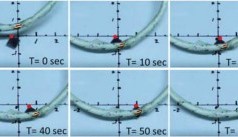A Free-Swimming Chip
on

A research team from National Taiwan University, National Taipei University of Technology and Chang Gung University have described how they developed a free-swimming remote-controlled bare die at the IEEE International Solid-State circuits Conference (ISSCC) in San Francisco. The 21.2 mm square die made by TSMC using a 0.35 µm process, is able to travel at 0.3 mm/s submerged in a liquid. A similar device was presented at the ISSCC in 2012, which used Lorentz forces for propulsion. This design however uses electrodes along the four edges of the chip to generate bubbles as a product of electrolysis.
Selectively switching voltage to the four electrodes, controls which of the edges produces bubbles and the chip’s direction of motion. Power and control signals to the chip are provided by an inductive loop positioned above the liquid. Operating at 10 MHz this loop induces sufficient energy in two on-chip coils to power the device. Amplitude modulation of this signal provides control information to steer the chip. The chip’s microcontroller decodes the demodulated control bit stream and switches power to the four electrodes.
It is anticipated that the technology will be useful for future in-body medical scanning applications.


Discussion (0 comments)